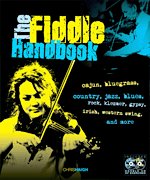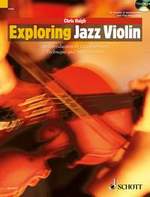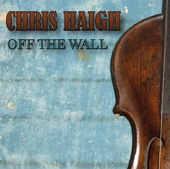
MENU TO FIDDLE STYLES:
HARMONICS ON THE FIDDLE
For many fiddlers, harmonics amount to nothing more than one of the miscellaneous noises that the fiddle can produce when your finger slips, your bow fumbles, or you accidentally bounce your fiddle off the floor. However, in the right context, they can work as a very useful “special effect”, extending both the melodic and expressive range of the instrument.
So first of all, what are harmonics? When you draw the bow across an open string, you hear a single, clear note, sometimes referred to as the fundamental. The string is vibrating along its full length producing, for example, a G note from the G string. If you lightly place your first finger right in the middle of the string, and bow again, this time you will hear a note an octave higher, and with a different character to the sound. The string is now vibrating equally on either side of your finger. Because the two halves are shorter than the whole string, the pitch is higher, and because they’re exactly half the length, the pitch is exactly an octave higher. The point at the centre of the string is called a harmonic node, and there are quite a few others on the string if you know where to look for them.
Now try dividing the string into quarters. Halfway between the bottom (nut) end of the string and the middle of the string is another node. If you were in third position on the G string, lightly fingering to play a C note (with your first finger), this would produce another G note. Not surprisingly, since it’s now a quarter of the string, it produces a note 2 octaves above the open G. You can get the same note three quarters of the way up the string (towards the bridge). In fact all the harmonics of the lower half of the string are mirrored in the upper half, though of course they’re harder to access.
GRAPPELLI'S VIOLIN HARMONICS
Now, staying in third position on the G string, try out your second finger, as if you were playing a D. It does actually sound a D, but an octave higher. This node is a third of the length of the string. Try further up the string, and you’ll find that the node at two thirds sounds exactly the same. Some of you are probably already thinking that this is about as useful as the Roman invasion of Britain. What did the harmonics ever do for us? The most famous jazz violinist of the 20th Century, Stephane Grappelli, found these ¼ and 1/3 string harmonics so useful that they littered his playing on almost every number. His favourite pattern was in third position, using his fingers 2,1 (G string), 2,1 (D string) and 2,1 (A string), and then down again, all in quick succession. He based the melodies of several of his tunes on these harmonics, notably Daphne and HCQ Strut. When I first started playing in Grappelli style, I always assumed that he played these harmonics in the upper half of the fiddle, with his fourth finger. It was a long time before I realised that you could get the same notes down at the lower end, where they are much more accessible.
Are there any more nodes? Yes. Staying in third position on the G string, try your third finger, as if playing an E note. It sounds as a high B. This is 2/5 of the way up the string. From what we’ve already learned, we can predict, correctly, that the same node can be got from a lower node (at 1/5)and two higher ones (at 3/5 and 4/5). Using the six harmonics available in third position on the G and D strings, it’s possible to play the opening phrase of the Marseillaise- a neat trick for topping off a gypsy jazz ballad. Or using the G, D and A strings you also have all the notes you need to play the theme from Close Encounters- essential if you ever get involved in a session with alien fiddle players. As far as I’m aware, Grappelli only ever used the second and first finger (1/4 and 1/3) harmonics. The American Joe Venuti, the master of tricks and special effects, made much more extensive and imaginative use of harmonics, also using the 3rd finger (1/5) harmonics.
DIDIER LOCKWOOD'S HARMONICS
A startling effect using harmonic nodes was perfected by the contemporary French jazz violinist Didier Lockwood. He realised that by sliding a single finger loosely up or down a string, you could make a whole series of harmonics ring in turn. To try this, put your second finger in the middle of the G string, then, fingering very lightly, slowly slide all the way up to the top of the bridge and down again. At first you might only hear white noise, but with a bit of practice you’ll get a whole series of harmonics. It’s less easy on the other strings, and you don’t get the same effect going down from the middle instead of up, probably because part of what you hear is not just the harmonics, but also some of the pitch you would hear if the finger were pressed right down. The effect is enhanced when you’re using an electric violin, with heaps of delay; it can then be a real party trick.
What we’ve been looking at so far are what are called natural harmonics. Aside from the various uses by jazz violinists, they don’t get used much in fiddle music. Perhaps the commonest use is the fourth finger slide up to the harmonic in the middle of the E string; useful in some gypsy tunes, or in American contest fiddle tunes such as Limerock. The great Scottish fiddler and composer Scott Skinner, never backward in coming forward when it came to showy technique, used natural harmonics in some of his more devilish pieces such as The President and The Duchess Tree. So is that it for harmonics? Far from it. As if it weren’t complicated enough already, there are also artificial harmonics.
ARTIFICIAL HARMONICS ON THE FIDDLE
Put your first finger down in first position on the G string, firmly this time, to play an A. While keeping this down, place your fourth finger lightly on the same string, as if to play a D note. What you should hear is a A harmonic note two octaves above the one you expected -the fundamental. Whereas all the natural harmonics were using fractions of the full length of the string, by pressing your first finger down, you are effectively shortening the string, whilst your fourth finger is creating a 1/4 harmonic of whatever note the first finger creates. The two big advantages of this over the natural harmonics are;
1. It’s a lot easier to predict what note you’re going to create, and
2. Whereas the natural harmonics were limited to a few parts of the scale, the artificial ones can create any note, and even slide between tones and semitones.
The big disadvantage will soon become clear when you try producing some higher notes. Slide your whole hand up a tone, still with your first finger down firmly and your fourth finger down lightly, and you should be able to sound a harmonic B. Carry on up and you can produce a whole scale. However, not only is it challenging to even a good classical player to play a scale with just your first finger, but you’ll quickly realise that the distance from your first to your fourth finger will decrease each time you move up, making it very hard to play accurately. The most likely place you will have come across artificial harmonics is in the middle, slow section of Monti’s pastiche Hungarian gypsy number Czardas. You’ll also hear them in Tchaikovsky’s Violin Concerto and, not to be outdone, Scott Skinner slipped them into his Madam Vanoni. A fiddler who uses them a lot is the contemporary gypsy from Budapest, the brilliant Roby Lakatos.
SUL PONTICELLO
There’s another effect similar in some ways to artificial harmonics, but a lot easier. It’s sometimes called Sul Ponticello. Bow a normal A note, first position, G string. Now play the same note again, but with a lot less bow pressure. You will still hear the fundamental note, but on top of it you will hear a lot of high harmonic “noise”, making a much dirtier note. By altering the pressure of the bow, you can produce different harmonics. You can get the same effect by moving your bow closer to the bridge (hence the name: sul ponticello means "on the bridge"). I find it a lot easier to achieve the effect by using bow pressure rather than moving close to the bridge. Using this effect you can produce a ghostly whisper, whilst still fingering as normal. It’s very useful for gypsy jazz ballads; the best example of these “ghost harmonics”, along with both natural and artificial harmonics, is Didier Lockwood’s version of Nuages on his Tribute to Stephane Grappelli album- easily my favourite of any jazz violin track. The ghost harmonic effect also passes as a very good imitation of guitar feedback, or the “pinched harmonic” effect much beloved by heavy rock guitarists. Trilling between E and G on the D string, then swirling up and down a minor pentatonic scale, and you’ll almost believe you were Jimi Hendrix. It’s an effect used by most violinists who venture into rock music.
VIOLIN SUBHARMONICS
Finally, something you’ll scarcely believe. Subharmonics. These are notes which can be produced LOWER than the fundamental. If you play an open G, and dig in really hard and slow with the bow, close to the fingerboard, you’ll produce a horrible grating sound. However, somewhere in that painful acoustic mire there is a clean note an octave below the G.. And also , by subtly altering the pressure, you can produce other notes at various intervals between the fundamental and the lower octave. The first and only violinist to make any serious use of subharmonics is the Japanese American Mari Kimura. She has written and recorded pieces using subharmonics, including her CD “The World below G and beyond”. You can hear samples on her website. Warning! This is one technique that definitely won’t come easy, and the practice required will almost certainly lead to you suffering domestic violence, if not a vicious but well deserved axe murder!
Here's Mari making it look easy:
(This article first appeared in Fiddle On magazine)


